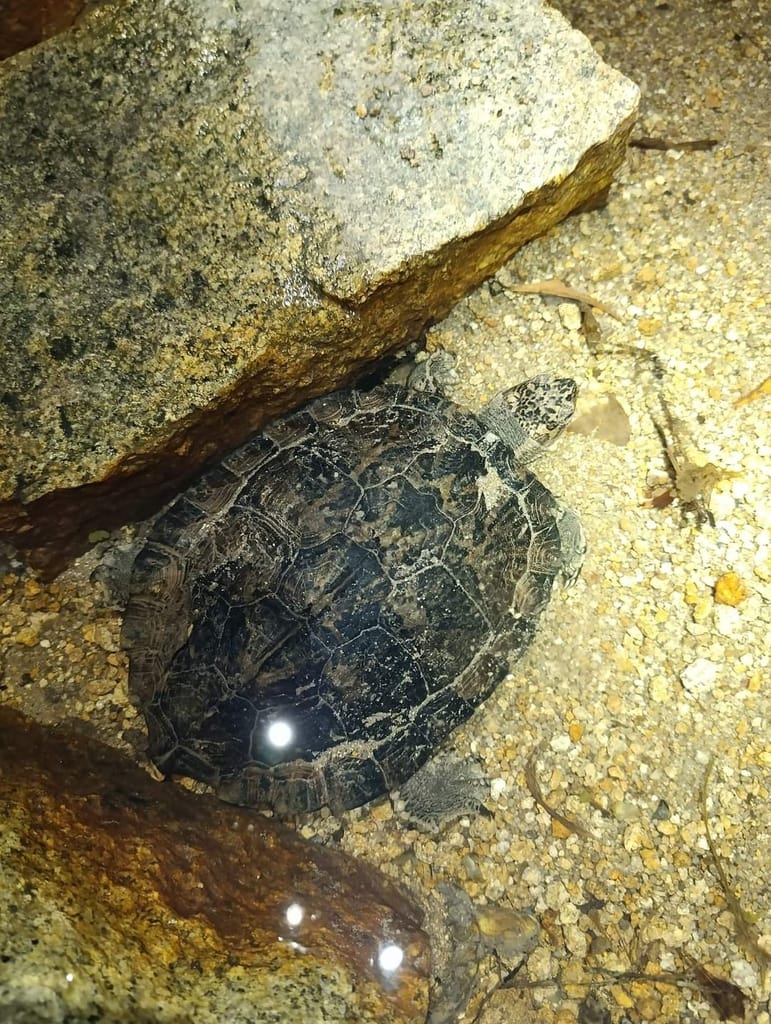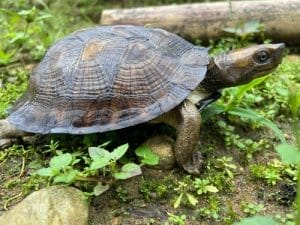Cyclemys pulchristriata (Eastern black-bridged leaf turtle)
Home > Turtle Database > Cyclemys pulchristriata (Eastern black-bridged leaf turtle)
Cyclemys pulchristriata, commonly known as the Eastern black-bridged leaf turtle, is a semi-aquatic species of turtle primarily found in Southeast Asia. With a distinctive brown and yellow pattern on its shell, this species thrives in freshwater environments such as rivers and streams, showing adaptability to a variety of habitats.
Native Turtle Species Map – Find Turtles by Region
Scientific Classification
- Kingdom: Animalia
- Phylum: Chordata
- Class: Reptilia
- Order: Testudines
- Family: Geoemydidae
- Genus: Cyclemys
- Species: Cyclemys pulchristriata
Common Names
- Eastern black-bridged leaf turtle
This Hilarious Turtle Book Might Know Your Pet Better Than You Do
Let’s be real—most turtle care guides feel like reading a textbook written by a sleep-deprived zookeeper.
This one’s not that.
Told from the snarky point of view of a grumpy, judgmental turtle, 21 Turtle Truths You’ll Never Read in a Care Guide is packed with sarcasm, sass, and surprisingly useful insights.
And hey—you don’t have to commit to the whole thing just yet.
Grab 2 free truths from the ebook and get a taste of what your turtle really thinks about your setup, your food choices, and that weird plastic palm tree.
It’s funny, it’s honest, and if you’ve ever owned a turtle who glares at you like you’re the problem—you’ll feel seen.
Identification
Description
Cyclemys pulchristriata has a flattened, oval carapace with distinct yellow and brown stripes. The plastron is typically dark with light markings. The head is olive-colored, often with light streaks. Adults can grow up to 20 cm in length.
Sexual Dimorphism
Males tend to have longer, thicker tails compared to females, and the cloaca is positioned further from the body in males.
Check more turtles from the Cyclemys genus
Native Origin and Distribution
Geographical Range
This species is found in Southeast Asia, particularly in countries like Thailand, Cambodia, Laos, and Vietnam.
Preferred Habitat
Cyclemys pulchristriata prefers slow-moving freshwater habitats such as rivers, streams, and swamps with dense vegetation. They are also known to inhabit areas with access to both water and land for basking and resting.
Behavior
Feeding Habits
They are omnivorous, feeding on a mix of plant matter, small invertebrates, and occasionally carrion.
Predators
Predators include large birds, reptiles, and some mammals that prey on young turtles and eggs.
Reproduction
Breeding Season
The breeding season typically occurs during the rainy season, usually between May and September.
Reproductive Method
Females lay 2–6 eggs per clutch in shallow nests dug into soft soil. The incubation period lasts approximately 70–80 days.
Conservation
Extinction Status
Listed as Vulnerable on the IUCN Red List.
Threats
Major threats include habitat destruction due to deforestation, water pollution, and poaching for the pet trade and consumption.
Conservation Measures
Conservation efforts include habitat protection, breeding programs, and restrictions on the illegal pet trade.
Economic Importance
Cyclemys pulchristriata is sometimes captured for the pet trade and, in some regions, for local consumption.
Interesting Facts
- This species is capable of producing a strong odor as a defense mechanism against predators.
- The name “Leaf Turtle” comes from their carapace pattern, which resembles fallen leaves, providing camouflage in forested habitats.

About Author
Muntaseer Rahman started keeping pet turtles back in 2013. He also owns the largest Turtle & Tortoise Facebook community in Bangladesh. These days he is mostly active on Facebook.















